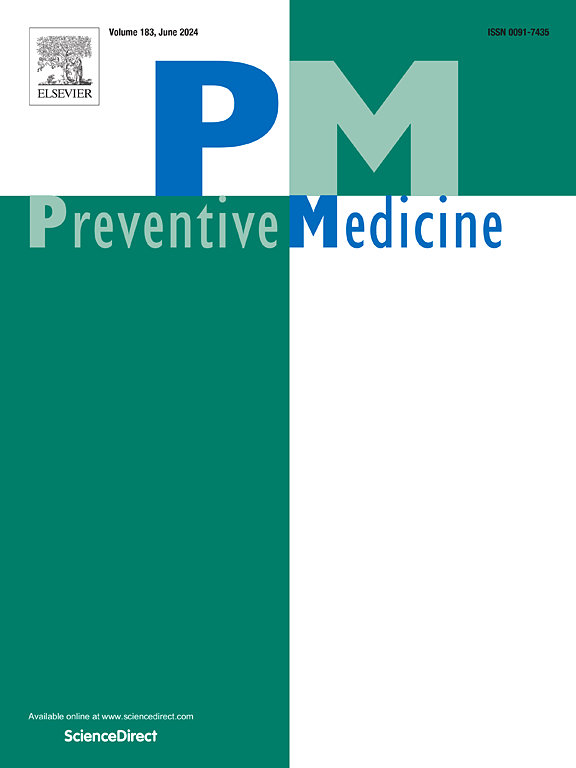Associations of urinary incontinence, physical activity and cardiovascular disease risk among women in the United States
IF 3.2
2区 医学
Q1 MEDICINE, GENERAL & INTERNAL
引用次数: 0
Abstract
Objective
Urinary incontinence (incontinence) is a common condition among women which may contribute to low moderate-to-vigorous physical activity (MVPA). Thus, women with incontinence may have increased risk for inactivity and related cardiovascular disease (CVD). The objective of this study was to determine the associations of incontinence with MVPA and CVD risk.
Methods
This retrospective observational study used electronic medical records to capture data on incontinence diagnosis, self-reported MVPA using the Exercise Vital Sign, CVD risk factors and diagnosis using ICD-10 codes, and demographic information from July 2022–June 2024 in Connecticut. Multinomial logistic regression assessed the association of incontinence and MVPA classification (inactive: 0 min/week, insufficiently active: 1–149 min/week, and active ≥150 min/week). Logistic regression models assessed associations of incontinence with CVD risk calculator components and diagnosed CVD. All models adjusted for age, race, body mass index, and tobacco use.
Results
Of 20,155 women who were included in analysis (mean age 50.36 ± 16.42 years), 5.4 % had an incontinence diagnosis. Compared to those without incontinence, those with incontinence did not differ in MVPA classification, but had greater odds of type two diabetes (aOR 1.25, 95 % CI: 1.06–1.48), dyslipidemia (aOR 1.37, 95 % CI: 1.19–1.58), stroke (aOR 1.55, 95 % CI: 1.06–2.25), and coronary artery bypass grafts (aOR 3.17, 95 % CI: 1.45–6.95) after adjustment.
Conclusions
Incontinence was not associated with MVPA classification but was associated with inactivity related CVD risk factors and cardiometabolic comorbid conditions. Future studies should investigate potential mechanisms of this association including incontinence severity, activity intensity, and chronic inflammation.
美国女性尿失禁、身体活动和心血管疾病风险的关系
目的尿失禁是女性的一种常见疾病,可能导致低、中、高强度的身体活动(MVPA)。因此,失禁的女性患不活动和相关心血管疾病(CVD)的风险可能增加。本研究的目的是确定尿失禁与MVPA和CVD风险的关系。方法回顾性观察性研究采用电子病历获取康州2022年7月至2024年6月期间尿失禁诊断、运动生命体征自报MVPA、ICD-10编码CVD危险因素和诊断数据以及人口统计信息。多项逻辑回归评估尿失禁与MVPA分类(不活动:0分钟/周,不充分活动:1-149分钟/周,活动≥150分钟/周)的关系。Logistic回归模型评估了尿失禁与CVD风险计算器组成部分和CVD诊断之间的关联。所有模型都根据年龄、种族、体重指数和吸烟情况进行了调整。结果纳入分析的20,155名女性(平均年龄50.36±16.42岁)中,5.4%诊断为尿失禁。与无尿失禁者相比,尿失禁者在MVPA分类上没有差异,但调整后2型糖尿病(aOR 1.25, 95% CI: 1.06-1.48)、脂质异常(aOR 1.37, 95% CI: 1.19-1.58)、中风(aOR 1.55, 95% CI: 1.06-2.25)和冠状动脉旁路移植术(aOR 3.17, 95% CI: 1.45-6.95)的发生率更高。结论尿失禁与MVPA分类无关,但与不活动相关的CVD危险因素和心脏代谢合并症有关。未来的研究应该调查这种关联的潜在机制,包括失禁严重程度、活动强度和慢性炎症。
本文章由计算机程序翻译,如有差异,请以英文原文为准。
求助全文
约1分钟内获得全文
求助全文
来源期刊

Preventive medicine
医学-公共卫生、环境卫生与职业卫生
CiteScore
7.70
自引率
3.90%
发文量
0
审稿时长
42 days
期刊介绍:
Founded in 1972 by Ernst Wynder, Preventive Medicine is an international scholarly journal that provides prompt publication of original articles on the science and practice of disease prevention, health promotion, and public health policymaking. Preventive Medicine aims to reward innovation. It will favor insightful observational studies, thoughtful explorations of health data, unsuspected new angles for existing hypotheses, robust randomized controlled trials, and impartial systematic reviews. Preventive Medicine''s ultimate goal is to publish research that will have an impact on the work of practitioners of disease prevention and health promotion, as well as of related disciplines.
 求助内容:
求助内容: 应助结果提醒方式:
应助结果提醒方式:


